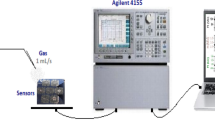Abstract
The Active and Assisted Living (AAL) paradigm has helped the expansion of the use of sensors, which is increasingly common in research work related to activity monitoring. However, one of the major disadvantages found in using sensors inside the home or other types of environment to monitor activities is the non-acceptance by users of having sensors around them because they may see their privacy compromised. Therefore, nowadays it is important to search for non-invasive and low-cost sensors that provide the user with the security and accessibility to feel comfortable with them. In this work a case study has been carried out with the design and construction of a Metal Oxide Semiconductors (MOS) sensor array with which it is intended to monitor the type of food used in the kitchen by means of the K-Nearest Neighbours (K-NN) machine learning method. Specifically, the case study presented seeks to differentiate between bananas, lemons, chorizo and prawns in a first approach as an intelligent electronic nose. Gas sensors have been used to take advantage of their non-invasive character for the user, although the disadvantage of not being widely explored in the scientific literature has been found. The results obtained in the case study presented in this paper to classify these four foods have been promising to advance in this research topic.
Funding for this research is provided by EU Horizon 2020 Pharaon Project ‘Pilots for Healthy and Active Ageing’, Grant agreement no. 857188. This contribution has been supported by the Spanish Institute of Health ISCIII by means of the project DTS21-00047 and by the Spanish Government under the project RTI2018-098979-A-I00 MCIN/AEI/10.13039/501100011033/, FEDER “Una manera de hacer Europa’.
Access this chapter
Tax calculation will be finalised at checkout
Purchases are for personal use only
Similar content being viewed by others
References
Aparicio, R., Rocha, S.M., Delgadillo, I., Morales, M.T.: Detection of rancid defect in virgin olive oil by the electronic nose. J. Agric. Food Chem. 48(3), 853–860 (2000). https://doi.org/10.1021/JF9814087
Chen, J., Gu, J., Zhang, R., Mao, Y., Tian, S.: Freshness evaluation of three kinds of meats based on the electronic nose. Sensors 19(3), 605 (2019). https://doi.org/10.3390/S19030605
Chen, L.Y., Wu, C.C., Chou, T.I., Chiu, S.W., Tang, K.T.: Development of a dual mos electronic nose/camera system for improving fruit ripeness classification. Sensors 18(10), 3256 (2018). https://doi.org/10.3390/S18103256
Chen, R., Formenti, F., McPeak, H., Obeid, A.N., Hahn, C.E.W., Farmery, A.D.: Optimizing design for polymer fiber optic oxygen sensors. IEEE Sens. J. 14(10), 3358–3364 (2014). https://doi.org/10.1109/JSEN.2014.2330359
Cramp, A., Sohn, J., James, P.J.: Detection of cutaneous myiasis in sheep using an ‘electronic nose’. Vet. Parasitol. 166(3–4), 293–298 (2009). https://doi.org/10.1016/j.vetpar.2009.08.025
Dudhe, P., Kadam, N., Hushangabade, R., Deshmukh, M.: Internet of things (iot): an overview and its applications. In: 2017 International Conference on Energy, Communication, Data Analytics and Soft Computing (ICECDS), pp. 2650–2653. IEEE (2017). https://doi.org/10.1109/ICECDS.2017.8389935
Emadi, T.A., Shafai, C., Freund, M.S., Thomson, D.J., Jayas, D.S., White, N.D.G.: Development of a polymer-based gas sensor - humidity and coinf2/inf sensitivity. In: 2009 2nd Microsystems and Nanoelectronics Research Conference. pp. 112–115 (2009). https://doi.org/10.1109/MNRC15848.2009.5338948
Grossel, S.S.: Hazardous gas monitoring: a guide for semiconductor and other hazardous occupancies (2000)-logan t. white, noyes publications/william andrew publishing, 13 eaton avenue, norwich, ny 13815, 206 pages, $85.00. Journal of Loss Prevention in the Process Industries 3(15), 249–250 (2002)
Liu, X., Cheng, S., Liu, H., Hu, S., Zhang, D., Ning, H.: A survey on gas sensing technology. Sensors 12(7), 9635–9665 (2012). https://doi.org/10.3390/s120709635
Madakam, S., Lake, V., Lake, V., Lake, V., et al.: Internet of things (IoT): a literature review. J. Comput. Commun. 3(05), 164 (2015). https://doi.org/10.4236/jcc.2015.35021
Manzoli, A., et al.: Volatile compounds monitoring as indicative of female cattle fertile period using electronic nose. Sens. Actuators B: Chem. 282, 609–616 (2019). https://doi.org/10.1016/j.snb.2018.11.109
Qiao, J., Su, G., Liu, C., Zou, Y., Chang, Z., Yu, H., Wang, L., Guo, R.: Study on the application of electronic nose technology in the detection for the artificial ripening of crab apples. Horticulturae 8(5), 386 (2022). https://doi.org/10.3390/horticulturae8050386
Ruiz Simões, F., Xavier, M.: Electrochemical Sensors, pp. 155–178 (2017). https://doi.org/10.1016/B978-0-323-49780-0.00006-5
Shengyin, Y., Minglei, S.: An acoustic method on sulfur hexafluoride concentration detection. In: 2014 IEEE Workshop on Electronics, Computer and Applications, pp. 485–488 (2014). https://doi.org/10.1109/IWECA.2014.6845663
Siegel, C., Dorner, T.E.: Information technologies for active and assisted living-influences to the quality of life of an ageing society. Int. J. Med. Informatics 100, 32–45 (2017). https://doi.org/10.1016/j.ijmedinf.2017.01.012
Srinivasan, P., Robinson, J., Geevaretnam, J., Rayappan, J.B.B.: Development of electronic nose (shrimp-nose) for the determination of perishable quality and shelf-life of cultured pacific white shrimp (litopenaeus vannamei). Sens. Actuators, B Chem. 317, 128192 (2020). https://doi.org/10.1016/j.snb.2020.128192
Voss, H.G.J., Mendes Júnior, J.J.A., Farinelli, M.E., Stevan, S.L.: A prototype to detect the alcohol content of beers based on an electronic nose. Sensors 19(11), 2646 (2019). https://doi.org/10.3390/s19112646
Westenbrink, E., Arasaradnam, R.P., O’Connell, N., Bailey, C., Nwokolo, C., Bardhan, K.D., Covington, J.A.: Development and application of a new electronic nose instrument for the detection of colorectal cancer. Biosens. Bioelectron. 67, 733–738 (2015). https://doi.org/10.1016/j.bios.2014.10.044
Yamazoe, N., Shimanoe, K.: Theory of power laws for semiconductor gas sensors. Sens. Actuators, B Chem. 128(2), 566–573 (2008). https://doi.org/10.1016/j.snb.2007.07.036
Yu, K., Wang, Y., Yu, J., Wang, P.: A portable electronic nose intended for home healthcare based on a mixed sensor array and multiple desorption methods. Sens. Lett. 9(2), 876–883 (2011). https://doi.org/10.1166/sl.2011.1635
Author information
Authors and Affiliations
Corresponding author
Editor information
Editors and Affiliations
Rights and permissions
Copyright information
© 2022 The Author(s), under exclusive license to Springer Nature Switzerland AG
About this paper
Cite this paper
Montoro-Lendínez, A., Pombo, N., Silva, B., Espinilla-Estévez, M., Medina-Quero, J. (2022). Classification of Food Types in a Box with Gas Sensors Using a Machine Learning Method. Case Study of Intelligent Electronic Nose. In: Guarda, T., Portela, F., Augusto, M.F. (eds) Advanced Research in Technologies, Information, Innovation and Sustainability. ARTIIS 2022. Communications in Computer and Information Science, vol 1675. Springer, Cham. https://doi.org/10.1007/978-3-031-20319-0_37
Download citation
DOI: https://doi.org/10.1007/978-3-031-20319-0_37
Published:
Publisher Name: Springer, Cham
Print ISBN: 978-3-031-20318-3
Online ISBN: 978-3-031-20319-0
eBook Packages: Computer ScienceComputer Science (R0)




